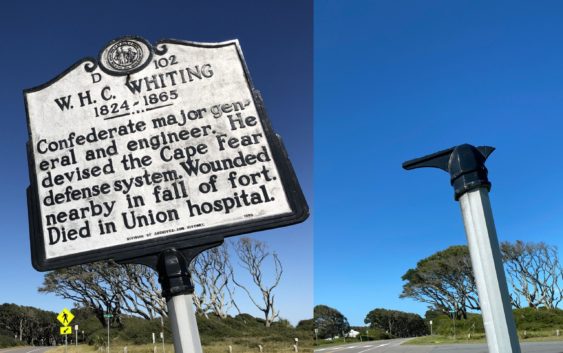- Artists transform hurricane aftermath into hoop-inspired masterpieces at Charlotte exhibit
- NC's cost for Hurricane Helene damage is nearly $60 billion, state says
- State to develop drone program to better respond to disasters like Helene, Florence
- South Carolina residents face deadline to get storm debris out to the curb after Hurricane Helene
- SCDOT to pick up Hurricane Helene debris for a final day in South Carolina
Hurricanes, mowers, cars: Threats abound for Wilmington-area highway historic markers

Markers at Fort Fisher and in downtown Wilmington have fallen in the last month
WILMINGTON – The three biggest enemies of the state’s highway historic marker program all struck within the last month in the Cape Fear.
Hurricanes, lawnmowers and cars are the chief culprits of broken, damaged or fallen markers, the eye-catching silver plaques that sit atop posts all over the state detailing the historical significance of past residents and events. Seventy markers stand in New Hanover County alone and more than 1,600 can be found across North Carolina.
As the tropics continue to churn up prospective storms and afternoon showers keep the grass watered, marker program administrator Ansley Wegner said the summer keeps her busy.
“Between hurricanes and lawnmowers, this is the worst part of my year,” Wegner said. “Careless drivers are a year-round problem.”
In the past month, at least four have come down in the region, including two at Fort Fisher thanks to Hurricane Isaias. For the entire state, Wegner gets at least one report of a downed marker each week.
Unfortunately, due to current budget constraints in the N.C. Department of Transportation, which funds the program, any marker that succumbs to one of these foes is not likely to be repaired or replaced anytime soon.
We Unearth local history: Get our free email newsletter for podcasts, stories and photos from Cape Fear Unearthed
“It will be years,” Wegner said. “I didn’t get any of my budget for the 2019-20 fiscal year, which means I’ve been without money since April 2019. I’m just hoping we get some by August 2021.”
On Aug. 3, Hurricane Isaias claimed two markers at Fort Fisher – one designating the site of the Confederate fort and one acknowledging Gen. W.H.C. Whiting, who helped build it.
The Whiting one has been recovered, but the Fort Fisher marker remains at large, Wegner said.
Then, she was notified the marker for Royal Governor Arthur Dobbs, one of eight markers that stand along N.C. 133 outside the Brunswick Town/Fort Anderson State Historic Site, was knocked off its post and possibly run over by a lawnmower.
The plaque to Mary Baker Glover Eddy, the founder of the Christian Science Church, that once stood near the New Hanover County Courthouse on Third Street downtown was hit by a car recently and taken down.
A marker for Confederate and Egyptian War lieutenant William Loring at Orange and Third streets is also missing, possibly due to the hurricane.
Wegner said some of the fallen markers still missing might have been stolen to be displayed at home or sold, but it is against the law for the state property to be owned by residents.
These recent casualties are in addition to several that still have yet to be replaced or repaired following Hurricane Florence in 2018, including Thalian Hall and Lumina, the 20th century pavilion in Wrightsville Beach. For the entire state, 32 markers need to be ordered and 14 more need repairs.
Repairing a damage marker can cost between $850 and $1,200, Wegner said.
Paying for each one is a sizable chunk out of her budget, especially when hurricanes don’t come back to pay for damages and specific car accidents don’t often get reported along with marker damage.
With the program’s $60,000 annual budget split between a list of new plaques waiting to go up and needed repairs, it could take a long time before the latest victims are up and educating passing drivers once again.
Wegner said there’s been talk of establishing an endowment that could help fund repairs.
“People have called me up and offered to write a check to fix a specific marker, but we have no way of accepting private money for that purpose right now,” she said.
Additionally, the program’s markers have also been increasingly at the mercy of vandals.
As the country continues to examine its more fraught history, especially that tied to the Civil War, several markers have been vandalized in 2020.
In Brunswick County, one of two markers for Orton Plantation was spray painted in Belville. The town cleaned the marker off before Wegner was even notified of the incident.
Until she can do anything about them, the markers that need repairs or replacement will be stored with the NCDOT while the program waits to be financially replenished.
But Wegner also needs residents to help keep an eye on them in their own communities.
Since last year, volunteers have placed stickers on nearly every marker in the state. If someone finds a fallen or damaged marker, they should follow the instructions on the marker, file an online report or email ncmarkers@ncdcr.gov.
Reporter Hunter Ingram can be reached at 910-343-2327 or Hunter.Ingram@StarNewsOnline.com.